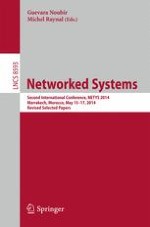This book constitutes the revised selected papers of the Second International Conference on Networked Systems, NETYS 2014, held in Marrakech, Morocco, in May 2014. The 20 full papers and the 6 short papers presented together with 2 keynotes were carefully reviewed and selected from 80 submissions. They address major topics such as multi-core architectures; concurrent and distributed algorithms; middleware environments; storage clusters; social networks; peer-to-peer networks; sensor networks; wireless and mobile networks; as well as privacy and security measures to protect such networked systems and data from attack and abuse.
